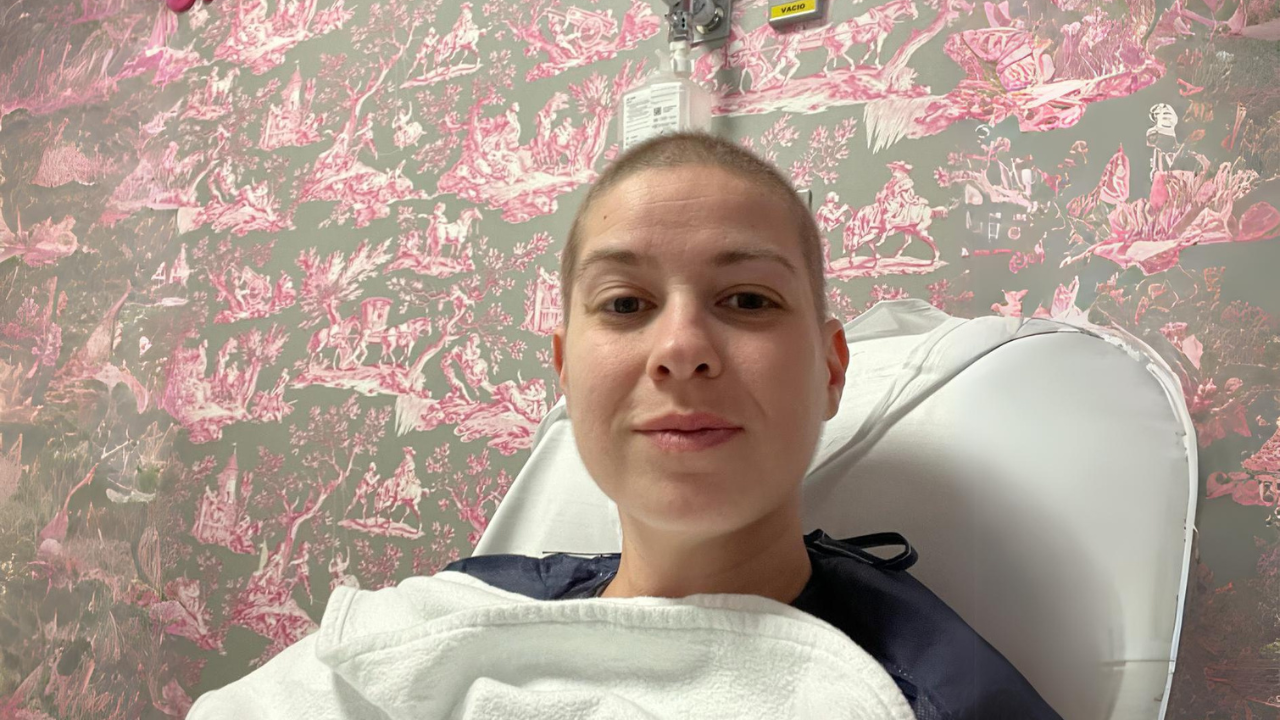Natalia Plaez during one of the chemotherapy cycles she had to undergo.
Natalia Pelez was diagnosed with non-Hodgkin lymphoma last year
June 6, 2024 . Updated at 11:46 a.m.
The largest study on the increase in the incidence of cancer in young people under 50 years of age, published in the journal BMJ Oncology, concluded that between 1990 and 2019 the global incidence of early-onset cancer increased by 79.1%. A reality that, unfortunately, also catches its protagonists by surprise. The first time I heard of non-Hodgkin’s lymphoma was when I was diagnosed with it, confirms Natalia Pelez. Until that happened, many tests and medical appointments were necessary. At 33 years old, he is one of the rare cases in which the disease occurs before the age of 67; since its incidence increases with age.
An odyssey to reach the diagnosis
It all started with shingles. Shortly after, I suffered a little cough, but I didn’t think it was important: Since I usually have allergies around April or May, I could get a little early due to the weather. She was still present and in June, she returned for consultation. I thought it could be a poorly treated pneumonia or a respiratory infection. The family doctor sent him the first test: a chest x-ray. He went directly to the emergency room. They put her in a room and her husband arrived. The hematologist came in and she told me that it looked like a possible lymphoma, but that the tests and tumor markers were fine, so they couldn’t rule out other options such as various types of infections.
Months continued to pass and a very strong pain occurred in my left arm. Also, the vein that runs through my neck swells. They do a CT scan and after this, they ask for a biopsy. The results no longer left room for doubt, but the truth is that five months pass from the time he goes to the doctor for the first time until they confirm that it is non-Hodgkin’s lymphoma. It turns out that it is more widespread than they believed, in stage IV. We had to start the treatment now, Because if not, it could continue progressing to other organs, Natalia laments. An advance that, according to her words, could have been less, but I want to record everything I have gone through due to the poor functioning of Social Security; I know it’s not their fault, but rather the system’s fault, because they are at full capacity, but everything can’t go so slowly.
What is non-Hodgkin lymphoma? This is the tumor from which Antonio Ibez died
Cinthya Martínez
The effects of chemotherapy
On August 14 of last year he began chemotherapy. The hardest thing was leaving my child, who was three years old at the time, when I was admitted to the hospital. Five days there, fifteen at home. And before entering the second cycle, he shaved his head: He didn’t want it to be a shock for the little one, so both his father and I did it.
Already in the third cycle, Natalia’s body begins to suffer. The level goes up and they give you more medication, you get worse, she comments. After this they performed a PET CT scan and it shows that I am clean. However, they recommend continuing with new phases of treatment in case any cells reproduce, as a preventive method against a possible recurrence. I accept, but it is a reality that, every time I level up, I feel worse.
After the fourth, he gets renal colic. He also starts having severe headaches, seeing black and blurry. Even so, the medical team decides to give him a fifth cycle. But I knew that if they gave me another one, he would kill me. The topic of the eyes comes back to me and the neurologist confirms that it was most likely that they went too far with the chemo, says Natalia.
As the months went by, he felt better. A few weeks ago they confirmed that she was clean, although she has to go for check-ups. First every four months, then six, every year and, after five, if everything is fine, they discharge you. When they told me that she was cured it was a rush, but I am aware that, Even though I’m 33 years old, I feel like I’m in a 53-year-old body.. What they put in you to kill the bad is still a poison.
Among the side effects he suffers from the treatment are bone pain, and he confesses that he gets very tired. Psychologically, Natalia thinks a lot about a possible relapse, or about possible pathologies that may occur in the future: A heart or kidney problem are pathologies that I can suffer in the long run because my organs have suffered a lot.
Although physically he is better, he continues to work psychologically: My psychology is helping me, to which I go thanks to the Spanish Association against Cancer (AECC). I still have to overcome that cancer duel. I am aware that I have a lot left to process and heal.
TheAECCseeks to reduce the impact of cancer on society by supporting patients and their families, with completely free programs and services such as psychological and social care, speech therapy, physiotherapy and nutrition, as well as support through volunteers.
All its programs and services are free for all patients and families who need it.
They are available 24 hours a day, 365 days a year on the toll-free telephone number. 900 100 036.

